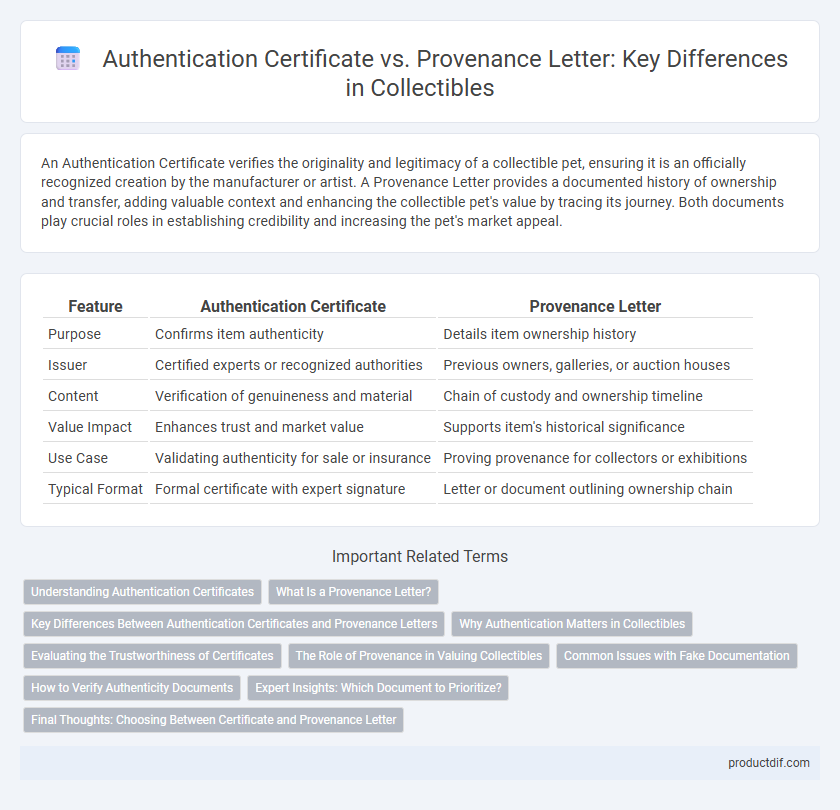An Authentication Certificate verifies the originality and legitimacy of a collectible pet, ensuring it is an officially recognized creation by the manufacturer or artist. A Provenance Letter provides a documented history of ownership and transfer, adding valuable context and enhancing the collectible pet's value by tracing its journey. Both documents play crucial roles in establishing credibility and increasing the pet's market appeal.
Table of Comparison
| Feature | Authentication Certificate | Provenance Letter |
|---|---|---|
| Purpose | Confirms item authenticity | Details item ownership history |
| Issuer | Certified experts or recognized authorities | Previous owners, galleries, or auction houses |
| Content | Verification of genuineness and material | Chain of custody and ownership timeline |
| Value Impact | Enhances trust and market value | Supports item's historical significance |
| Use Case | Validating authenticity for sale or insurance | Proving provenance for collectors or exhibitions |
| Typical Format | Formal certificate with expert signature | Letter or document outlining ownership chain |
Understanding Authentication Certificates
Authentication certificates validate the originality of collectibles by providing verified details about the item's creator, materials, and production date. These certificates are issued by recognized experts or authorities, ensuring credibility and increasing the collectible's market value. Understanding the role of authentication certificates is crucial for collectors to distinguish genuine pieces from counterfeits effectively.
What Is a Provenance Letter?
A provenance letter is a document detailing the history of ownership and origin of a collectible, providing evidence of its authenticity and legitimacy. Unlike an authentication certificate that verifies the item's genuineness through expert evaluation or scientific testing, a provenance letter traces the collectible's chain of custody, often including previous owners, exhibitions, and sales. This historical record enhances the collectible's value by establishing its background and confirming its legitimacy within the market.
Key Differences Between Authentication Certificates and Provenance Letters
Authentication certificates verify the originality and legitimacy of a collectible by providing expert analysis and confirmation of its authenticity. Provenance letters document the history of ownership and the item's journey through time, establishing its historical context and value. Key differences include the focus on physical verification in authentication certificates versus the emphasis on ownership record and historical significance in provenance letters.
Why Authentication Matters in Collectibles
Authentication certificates provide verified proof of a collectible's legitimacy through expert analysis and technology, ensuring buyers avoid forgeries. Provenance letters trace the ownership history but lack the rigorous validation that authentication certificates offer, making them less reliable in confirming authenticity. Authentication matters because it increases market value, builds collector trust, and protects investments from counterfeit risks.
Evaluating the Trustworthiness of Certificates
Evaluating the trustworthiness of authentication certificates and provenance letters requires verifying the issuer's credibility and the document's clarity in detailing the item's origin and history. Authentication certificates are typically issued by recognized experts or institutions, providing detailed verification based on scientific analysis or expert examination. Provenance letters focus on tracing ownership history, and their trustworthiness depends on documented evidence and consistency across records, making authentication certificates generally more reliable for confirming authenticity in collectibles.
The Role of Provenance in Valuing Collectibles
Provenance letters document the complete ownership history of collectibles, establishing authenticity and enhancing market value by tracing an item's origin and chain of custody. Authentication certificates confirm the genuineness of a collectible through expert verification but may lack detailed historical context. Provenance plays a crucial role in valuing collectibles by providing transparency, reducing risk of forgery, and increasing buyer confidence in the item's legitimacy and rarity.
Common Issues with Fake Documentation
Authentication certificates and provenance letters are crucial for verifying collectible authenticity but are often targeted by counterfeiters, leading to common issues such as forged signatures, inaccurate historical records, and fabricated issuing authorities. Collectors frequently encounter discrepancies in documentation details that undermine trust and complicate verification processes. Using advanced forensic analysis and database cross-referencing helps mitigate risks associated with fake documentation in the collectibles market.
How to Verify Authenticity Documents
To verify authenticity documents for collectibles, closely examine the certificate of authentication, ensuring it includes details such as issuer credentials, unique serial numbers, and tamper-proof features like holograms or embossed seals. A provenance letter should be cross-checked for a verifiable ownership history, matching transaction dates, and reputable third-party endorsements or archival records. Combining certificate validation with provenance verification enhances confidence in the collectible's legitimacy and market value.
Expert Insights: Which Document to Prioritize?
Authentication certificates provide verified confirmation from recognized experts or authorities, ensuring the collectible's legitimacy through detailed examination and documentation. Provenance letters trace the ownership history, offering a narrative that adds contextual value but may lack formal expert validation. Collectors should prioritize authentication certificates for guaranteed authenticity while using provenance letters to enhance the collectible's historical significance and market value.
Final Thoughts: Choosing Between Certificate and Provenance Letter
Selecting between an authentication certificate and a provenance letter depends on the collectible's value and origin importance. Authentication certificates provide verified proof of genuineness issued by experts, essential for high-value artwork or rare collectibles. Provenance letters detail the item's ownership history, enhancing credibility and potential appraisal for historically significant pieces.
Authentication Certificate vs Provenance Letter Infographic

 productdif.com
productdif.com